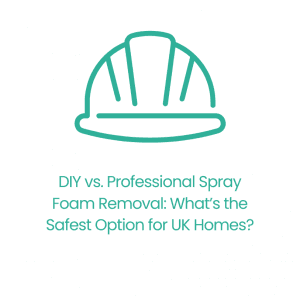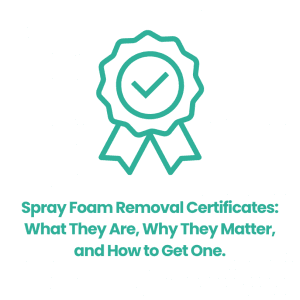If you’re considering spray foam removal to fix mortgage issues or prepare your home for sale, you’re probably wondering:
“How long does the removal process actually take?”
The short answer?
Anywhere from 1 to 5 days — depending on your property, the type of foam, and the access available.
In this guide, we’ll break down exactly what affects the timeline, what to expect each day, and how to make sure your removal is done properly — without delays or damage.
Average Spray Foam Removal Timeframe
| Property Type | Loft Size | Estimated Duration |
|---|---|---|
| Small flat or bungalow | <30m² | 1–2 days |
| Semi-detached home | 30–50m² | 2–3 days |
| Large detached house | 50m²+ | 3–5 days |
These are estimates based on manual removal using lender-approved methods.
Factors That Affect the Timeframe
1. Type of Spray Foam
Open-cell foam is softer and easier to remove.
Closed-cell foam is denser, harder to work with, and takes longer to remove properly.
2. Thickness and Coverage
Thicker foam layers or full coverage between rafters take more time to remove, especially if the foam is applied directly to tile underlay or membranes.
3. Loft Access and Space
Lofts with easy access and space to move around speed up the process. Tight hatches, low headroom or cluttered spaces will slow things down.
4. Quality of the Original Installation
If the foam was over-applied or sprayed unevenly, removal takes longer. Sloppy or careless installations are always harder to reverse.
5. Manual vs Non-Manual Methods
Only manual removal with specialist hand tools is accepted by most mortgage lenders. Power tools and solvents may seem faster, but they often leave residue or damage timbers — which can trigger survey issues.
What Happens Each Day?
A typical spray foam removal follows this structure:
Day 1 – Preparation
The team inspects the space, sets up protective sheeting, ensures safe access and begins exposing test areas of foam.
Day 2–3 – Manual Removal
Foam is removed in sections by hand, using specialist non-damaging tools. All debris is extracted using high-grade vacuums to keep dust under control.
Day 4 – Final Cleanup and Inspection
Remaining foam is removed, the roof is cleaned, and any timber visibility issues are addressed. Before-and-after photos are taken.
Day 5 – Certification and Reports (if required)
Some homeowners need a spray foam removal certificate to satisfy their mortgage lender or surveyor. A structural check or moisture inspection may also be included.
Can It Be Done in One Day?
In very small lofts with thin open-cell foam, yes — but it’s rare.
If a company claims they can remove foam from a standard roof in one day, be cautious. Rushed jobs often miss hidden foam, leave behind residue, or skip proper cleanup — which can all lead to mortgage issues down the line.
How to Avoid Delays
Work with a trusted specialist who uses manual removal techniques
Clear your loft space in advance
Make sure the property has accessible parking or scaffolding space
Choose a team that has dealt with both open-cell and closed-cell spray foam
Ask if they include post-removal inspection and documentation in their service
Why Removal Speed Shouldn’t Come at the Cost of Quality
It’s not just about how fast the foam comes out — it’s about doing it right.
Spray foam that’s poorly removed may still prevent surveyor approval. That means even after spending thousands, you could be back to square one.
A proper removal job should balance efficiency with care. Cutting corners to save a day or two often creates more headaches in the long run.


